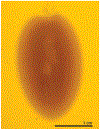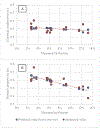Toward Image Data-Driven Predictive Modeling for Guiding Thermal Ablative Therapy
- PMID: 31494543
- PMCID: PMC7365264
- DOI: 10.1109/TBME.2019.2939686
Toward Image Data-Driven Predictive Modeling for Guiding Thermal Ablative Therapy
Abstract
Objective: Accurate prospective modeling of microwave ablation (MWA) procedures can provide powerful planning and navigational information to physicians. However, patient-specific tissue properties are generally unavailable and can vary based on factors such as relative perfusion and state of disease. Therefore, a need exists for modeling frameworks that account for variations in tissue properties.
Methods: In this study, we establish an inverse modeling approach to reconstruct a set of tissue properties that best fit the model-predicted and observed ablation zone extents in a series of phantoms of varying fat content. We then create a model of these tissue properties as a function of fat content and perform a comprehensive leave-one-out evaluation of the predictive property model. Furthermore, we validate the inverse-model predictions in a separate series of phantoms that include co-recorded temperature data.
Results: This model-based approach yielded thermal profiles in close agreement with experimental measurements in the series of validation phantoms (average root-mean-square error of 4.8 °C). The model-predicted ablation zones showed compelling overlap with observed ablations in both the series of validation phantoms (93.4 ± 2.2%) and the leave-one-out cross validation study (86.6 ± 5.3%). These results demonstrate an average improvement of 17.3% in predicted ablation zone overlap when comparing the presented property-model to properties derived from phantom component volume fractions.
Conclusion: These results demonstrate accurate model-predicted ablation estimates based on image-driven determination of tissue properties.
Significance: The work demonstrates, as a proof-of-concept, that physical modeling parameters can be linked with quantitative medical imaging to improve the utility of predictive procedural modeling for MWA.
Figures






References
-
- Alexander ES, Wolf FJ, Machan JT, Charpentier KP, Beland MD, Iannuccilli JD, Haas RH, and Dupuy DE, “Microwave ablation of focal hepatic malignancies regardless of size: A 9-year retrospective study of 64 patients,” Eur J Radiol, vol. 84, no. 6, pp. 1083–1090, 2015. - PubMed
-
- Martin RCG, Scoggins CR, and McMasters KM, “Safety and efficacy of microwave ablation of hepatic tumors: a prospective review of a 5-year experience,” Ann Surg Oncol, vol. 17, pp. 171–178, 2010. - PubMed
-
- Simon C, Dupuy DE, and Mayo-Smith WW, “Microwave ablation: principles and applications,” Radiographics, vol. 25, pp. S69–S83, 2005. - PubMed

